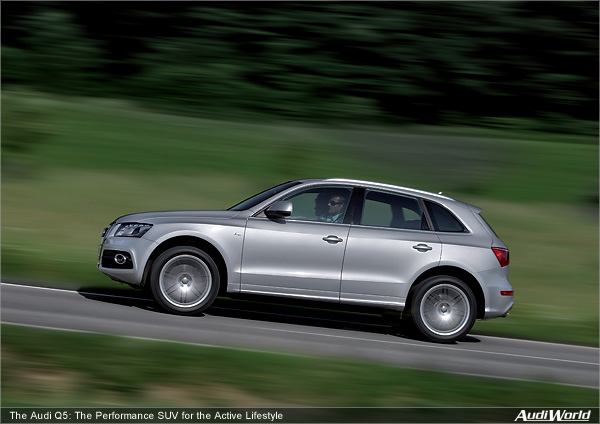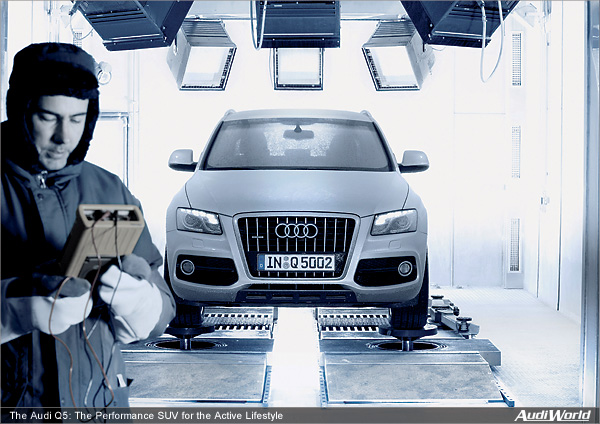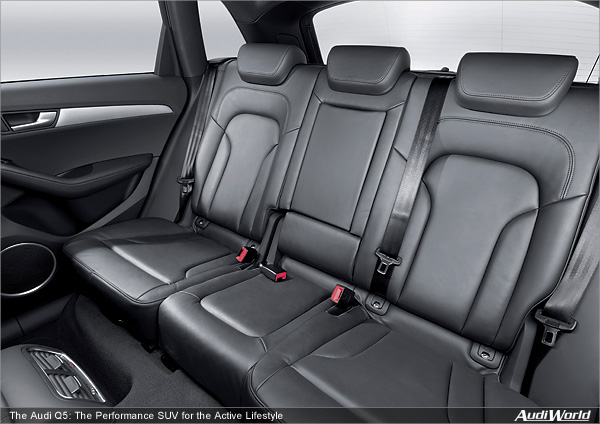Audi Q5: The Body

Elaborate aeroacoustics developed for the most part in a special acoustic wind tunnel keep the noise level low even when the car is traveling at high speeds. The Audi Q5 matches the exemplary standard of the Audi A4 in this respect. Influencing aeroacoustics involves juggling many different elements such as the triple door seals, the drip moldings on the A-posts and the exterior mirrors. Thanks to its rigid mount, the optional panoramic glass roof barely adds to the noise level.
The basic weight of the Audi Q5 at market launch is 1,730 kilograms (3836.04 lb), a low figure for an SUV of this size. The steel body is very light in weight, thanks to the intensive use of cutting-edge technologies. The super-strength steels that reinforce the center tunnel, inner sills, B-posts, longitudinal members and bulkhead cross-member in the luggage compartment have tensile strengths as high as 1,600 megapascals. Six Audi Q5 cars together weighing ten metric tons could be hung from a strip of this hot-formed material only two millimeters (0.08 in) thick and 30 millimeters (1.18 in) wide.
Hot forming is a hi-tech process. It involves heating blanks of boron steel to 950 degrees Celsius (1,742° F) in a conveyor oven and then quenching and shaping them in a cooled die. Their various zones can be heated to different temperatures in the oven, to produce a range of strength zones. In the event of a crash, the component is then deformed in precisely the desired manner.
In the case of the B-post, for instance, the lower zone is rather more ductile (deformable) than the upper zone, since this is where most energy has to be dissipated in the event of a side-on collision. The post and the rear longitudinal sections are manufactured in-house; Audi is the first carmaker to have installed such production facilities.
On the body of the Audi Q5 minus the doors, lids and metal panels super-strength hi-tech steels make up an impressive 9.1 percent of the overall weight. 3.3 percent is made from ultra-high-strength steels, 12.3 percent from higher-strength grades, 44.5 percent from high-strength steel and 30.8 percent from conventional deep-drawn steel.
Ultra-precise: welding and bonding
The way the body is put together is also a highly precise affair. The areas in which conventional resistance spot welding is used now account for only 73 percent of the total equivalent to about 5,000 weld points. To boost strength further, Audi uses bonding in some areas as well as or instead of welding. A two-pack adhesive forms the join in 17 percent of cases; the adhesive seams in the Q5 measure a total length of 83 meters (272.31 ft).
There are two particularly elaborate joining technologies among the remaining 10 percent. Laser welding is the method of choice around the sills and on the doors. The components in the visible part of the tailgate’s water channel, like the zero gap between the side section and roof, are created by hi-tech soldering methods. This zone is visible evidence of Audi’s uncompromising quality philosophy, epitomizing the precision joins running all across the body.
The use of ultramodern materials and joining techniques is the basis of the body’s rigidity. It keeps the noise level on board low and paves the way for superb drivability it is the basis for both low tire noise and sporty, precise handling. Achieving a homogeneous response by the entire body was one of the top priorities for global dynamic rigidity. The level of vibration was reduced even further at the “comfort points” at which the driver and passenger might detect vibration the steering wheel, the floor panel, around the feet and seats as well as around the mirrors.
A highly advanced system of transverse and longitudinal profiles and frames gives the Audi Q5 high torsional rigidity. The longitudinal member, the center tunnel and the side structure provide outstanding flexural strength. Components such as a cross-member between the suspension-strut domes specifically increase the forward structure’s rigidity.
The design engineers also gave top priority to local rigidity. All those points at which forces and vibration are introduced during driving were specifically reinforced, such as the connection between the front axle subframe, suspension and body. The subframe distributes excitation from the wheels through a framework structure of longitudinal and tunnel members, thus significantly reducing tire noise in important zones.
Uncompromising: long-term quality
Long-term quality is again a top priority in the Audi Q5, in keeping with the brand with the four rings. To protect against corrosion, all body cavities are flooded with hot liquid wax. Audi is the only premium brand to implement this method. During testing of the performance SUV, the design engineers tested quality with the help of the “INKA test” (Ingolstadt Corrosion and Aging Test). This 19-week procedure involved exposing the Audi Q5 to every conceivable environmental load in a variety of chambers salt spray, moist heat, dry heat and low temperatures down to -40° C (-40° F). This cycle was followed by a merciless shake test on a simulator and driving tests on the test track.
Occupant protection in the Q5 is also of the highest caliber and is a matter of honor for Audi. While developing the vehicle the brand was able to exploit the extensive resources of knowledge that it had built up internally. The AARU (Audi Accident Research Unit) exhaustively analyzes actual accident scenarios taking many different aspects into account.
In a frontal collision, a finely choreographed series of protective measures is triggered off. At the very start of the collision two acceleration sensors located well forward, beneath the headlamps, are alerted first. The front cross-member distributes the forces arising through the upper and lower longitudinal members, which dissipate these through defined deformation. The aluminum subframe that supports the front axle and engine diverts the forces into the floor and tunnel structure of the occupant compartment. The steering column is pushed away from the driver and the pedals are disengaged from their mounts.
Maximum safety: innovation in the airbag concept
In frontal collisions, people of slight build are at greater danger than sturdier people. Audi has therefore designed the restraint systems in the Q5 as an innovative, very closely meshed network. There are sensors on the front seat rails to detect how far forward or back the seat is positioned. This data is incorporated into the calculations of the control unit, which manages how the restraint systems operate. Because the computer knows how far the passenger is from the airbag, it can ensure that the amount of forward movement, during which the seat belt and the airbag can restrain the body, is optimally utilized.
The front airbags in the Audi Q5, with a capacity of 64 liters (2.26 cubic ft) on the left and 120 liters (4.24 cubic ft) on the right, have an adaptive concept and operate according to a new strategy. They always inflate fully. If the impact is not particularly severe and the passenger is positioned close to the airbag, the control unit rates the situation as relatively mild. In this instance some of the inflating gas is released again through valves; the head and chest are cushioned relatively gently.
If the crash is severe, on the other hand, the airbags remain fully inflated for longer. The same happens if the impact is not very strong but the passenger is sitting so far back that their torso would whip forward with great force. The conventional technology that triggers the airbag merely on the basis of a collision’s severity would inflate the airbag only partially, affording correspondingly poorer protection.
The belt force limiters, too, respond flexibly. They incorporate two torsion bars that are connected by toothed wheels. In less critical situations, the torsion bars are separated at an earlier stage in the accident. This gives the belt a greater range of movement the seat occupant’s upper body plunges relatively deeply into the airbag and the load that has to be withstood in the chest area is reduced. In a more severe crash situation, however, the torsion bars are either disconnected later or not at all the seat belt restrains the passenger more firmly.
Audi’s developers also took intelligent precautions for rear-end collisions, a common type of accident in city traffic that can often lead to whiplash injuries. The longitudinal member, rear wheels and sills dissipate the impact energy in a specific pattern; the fuel tank is in the protected zone ahead of the rear axle subframe. The battery, car jack and optional entertainment equipment are displaced into a precisely defined zone; the fuel pump is shut down, as in any more severe crash.
Integrated concept: the seats and head restraints
In the occupant compartment, the seats provide the passengers with excellent protection. The shape of the seat back frame, a soft sprung mat and an energy-absorbing foam enable the back to sink some way into the seat back. This allows the back of the head to be cushioned early on by the rigid head restraint, which is at a distance of only about four centimeters (1.57 in). In the case of a severe rear-end collision, the seat-belt tensioners are triggered so as to firmly hold the occupants in the best position in their seats.
This integral head restraint system, which is also used in other model series, has already proved effective for protecting passengers of any build in accidents of all levels of severity. It was awarded the rating “Good” in independent tests such as that conducted by the highly regarded International Insurance Whiplash Prevention Group (IIWPG), a work group that aims to prevent whiplash injuries.
The U.S. Insurance Institute for Highway Safety (IIHS), too, awarded it the rating “Good”. In Germany, the ADAC and leading trade periodicals arrived at similar results.
The Audi Q5 is also well equipped in the event of a side impact, in which the passengers are particularly exposed. Acceleration sensors in the C-posts and pressure sensors in the doors register the danger. The B-posts, the sills and two cross-members in the floor take on most of the deformation work. They are supported by the doors, the edges of which have a large overlap with the posts, sills and roof frame. Using their hinges, the door support members transfer the forces into the B-posts.
Inside the vehicle, protection in the event of a side impact is ensured by seat-integrated thorax/pelvis side airbags with a capacity of 13 liters (0.46 cubic ft) (optionally airbags with a capacity of 12 liters (0.42 cubic ft) on the rear seats) and continuous window bags with a capacity of 25.5 liters (0.9 cubic ft). Height-adjustable belts and anti-submarining ramps in the seats round off the restraint systems on the front seats; a sensor identifies whether the front passenger’s seat is occupied. If the driver or front passenger have not fastened their seat belts when the car moves away, a warning gong sounds from speeds of 25 km/h (15.53 mph) upwards. At the rear, the Audi Q5 is equipped with Isofix provisions for child seats as standard. Isofix catches can also be supplied optionally on the front passenger’s seat, together with a disabling function for the airbag.
Thanks to its spacious deformation space, the Audi Q5 meets all Japanese and European requirements for collisions with pedestrians. In the type-specific crash, which involves driving into a barrier at 15 km/h (9.32 mph) and a 40 percent overlap, crash boxes made from aluminum located ahead of the longitudinal members prevent damage to the body structure; the radiator can be displaced slightly to the rear thanks to its sliding mounts. Minor bumps of up to 4 km/h (2.49 mph) when maneuvering in parking lots do not leave any dents in the aprons, and after collisions at higher speeds these components can be changed individually.
The equipment, data and prices stated here refer to the model range offered for sale in Germany. Subject to amendment; errors and omissions excepted.
|


